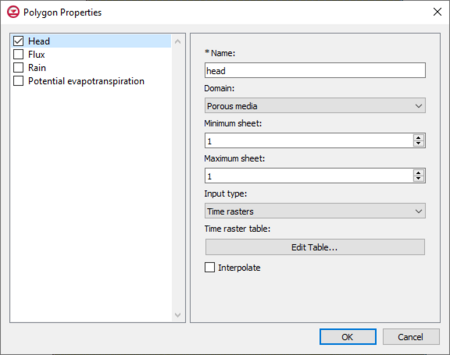GMS:HydroGeoSphere Polygon Properties
| HydroGeoSphere | |
|---|---|
| Models & Tools | |
|
HGS Simulation Control HGS Materials HGS Coverages HGS Arc Properties HGS Point Properties HGS Polygon Properties HGS Renumber UGrid | |
The Polygon Properties dialog in the HydroGeoSphere model is where a polygon or polygons can be assigned a boundary condition. There are four options for the polygon properties, which are listed on the left side of the dialog: head, flux, rain, and potential evapotranspiration. The input parameters are shown on the right when one of the four boundary conditions is selected. Only one type of boundary condition can be assigned to a feature object on a boundary conditions coverage.
Head or Flux
Head and flux are two separate available arc property types on a boundary conditions coverage, but the input options available are the same. Head is a general specified head boundary condition, and flux is a general specified flux boundary condition. The input options for head and flux are listed below.
- Name – The name of the boundary condition. Names should be unique and contain no white space.
- Domain – The domain in which the boundary conditions are applied.
- Porous media
- Minimum sheet – The minimum node sheet; boundary conditions are applied between the minimum and maximum node sheets.
- Maximum sheet – The maximum node sheet; boundary conditions are applied between the minimum and maximum node sheets.
- Input type – How the boundary condition data is specified.
- Constant – Constant value of the boundary condition.
- Time series – Time-varying values of the boundary condition. A table is generated using the XY Series Editor dialog that is opened by clicking the Edit XY Series button by either manually entering the data, or importing the data.
- Interpolate
- Time rasters – The Edit Table... button opens the Time raster table dialog where the data is entered by selecting a raster from outside GMS.
- Interpolate – Causes time-varying values to be interpolated, resulting in a smoother application of the time-varying function.
- Surface flow
- Input type – How the boundary condition data is specified.
- Constant – Constant value of the boundary condition.
- Time series – Time-varying values of the boundary condition. A table is generated using the XY Series Editor dialog that is opened by clicking the Edit XY Series button by either manually entering the data, or importing the data.
- Interpolate – Causes time-varying values to be interpolated, resulting in a smoother application of the time-varying function.
- Time rasters – The Edit Table... opens the Time raster table dialog where the data is entered by selecting a raster from outside GMS.
- Interpolate – Causes time-varying values to be interpolated, resulting in a smoother application of the time-varying function.
- Input type – How the boundary condition data is specified.
- Porous media
Rain or Potential Evapotranspiration
Rain is a general specified flux boundary condition that converts fluxes to nodal volumetric fluxes. Potential evapotranspiration is a specified flux which is used in conjunction with evapotranspiration properties and is applied as a second-type boundary condition. Rain and potential evapotranspiration are two different polygon boundary condition options, but they contain the same input parameter options, which are listed below.
- Name – The name of the boundary condition. Names should be unique and contain no white space.
- Input type – How the boundary condition data is specified.
- Constant – Constant value of the boundary condition.
- Time series – Time-varying values of the boundary condition. A table is generated using the XY Series Editor dialog that is opened by clicking the Edit XY Series button by either manually entering the data, or importing the data.
- Interpolate – Causes time-varying values to be interpolated, resulting in a smoother application of the time-varying function.
- Time raster table – The Edit Table... opens the Time raster table dialog where the data is entered by selecting a raster from outside GMS.
- Interpolate – Causes time-varying values to be interpolated, resulting in a smoother application of the time-varying function.
Related Topics
| GMS – Groundwater Modeling System | ||
|---|---|---|
| Modules: | 2D Grid • 2D Mesh • 2D Scatter Point • 3D Grid • 3D Mesh • 3D Scatter Point • Boreholes • GIS • Map • Solid • TINs • UGrids | |
| Models: | FEFLOW • FEMWATER • HydroGeoSphere • MODAEM • MODFLOW • MODPATH • mod-PATH3DU • MT3DMS • MT3D-USGS • PEST • PHT3D • RT3D • SEAM3D • SEAWAT • SEEP2D • T-PROGS • ZONEBUDGET | |
| Aquaveo | ||
